By Monique Garcia Gunther
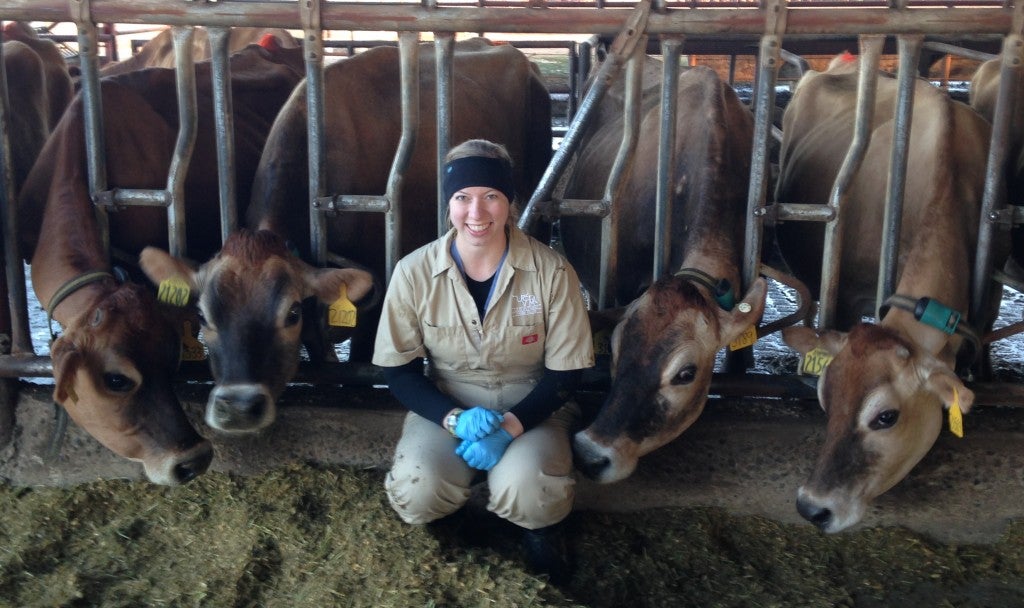 When Michelle Schack was seven years old, she was dissecting squirrels. At 17, she helped raise nine guide dogs. In college, as an undergraduate resident manager of an animal sciences barn, she lived with pigs for two years. Today, in her final year of DVM training at the UC Davis School of Veterinary Medicine, you’ll find Michelle outdoors working on a dairy farm diagnosing cattle pregnancies or treating a sick cow, as part of a rotation in dairy production medicine.
When Michelle Schack was seven years old, she was dissecting squirrels. At 17, she helped raise nine guide dogs. In college, as an undergraduate resident manager of an animal sciences barn, she lived with pigs for two years. Today, in her final year of DVM training at the UC Davis School of Veterinary Medicine, you’ll find Michelle outdoors working on a dairy farm diagnosing cattle pregnancies or treating a sick cow, as part of a rotation in dairy production medicine.
A city girl drawn to the farm
You might think Michelle grew up on a farm. Instead, she was raised in the traffic-filled suburbs of the San Francisco Bay Area where 4-H Clubs were hard to come by.
From an early age, Michelle said she knew she wanted to be a veterinarian and sought out opportunities to work with animals. But she was keenly aware that becoming a veterinarian involved more than a love for animals. While she owned dogs, a tortoise, a bunny and a bird as pets, she also possessed an inquiring mind, a strong sciences and math skill set and good communication skills. When she reached high school, she took anatomy and physiology to prepare for college.
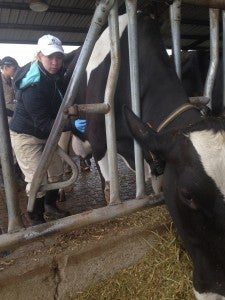 Choosing UC Davis for hands-on training with animals
Choosing UC Davis for hands-on training with animals
“I decided to go to UC Davis because I wanted to become a veterinarian,” Michelle said. As an animal science undergraduate major, she would gain the hands-on experience with animals she desired, and learn how they are raised and treated.
What she didn’t realize was that she would end up living at the campus pig barn for two years as the on- premise student herd manager.
“My roommates were pigs,” she laughed.
The turning point in choosing an academic path was when she had the opportunity to shadow a dairy veterinarian. While many of her colleagues were headed in the direction of caring for companion animals, like dogs and cats, she was interested in pursuing the less-popular field of food animal medicine within the agricultural sector. But unlike others pursuing this area of interest, Michelle didn’t come from a food animal background and didn’t grow up on a dairy.
“I found myself interested in how our food is made, how our food stays safe and the role education plays in the public perception of our food supply,” she said.
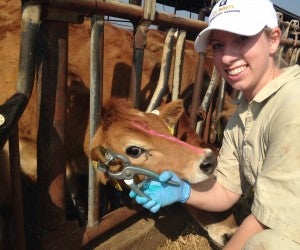 Preparing for the ‘real world’ in the heart of nation’s dairy industry
Preparing for the ‘real world’ in the heart of nation’s dairy industry
This spring she completed an optional rotation program through the school’s Dairy Production Medicine Program, located at the Veterinary Medicine Teaching and Research Center (VMTRC).
VMTRC trains about 40 senior veterinary students like Michelle each year, as well as post-graduate residents from around the world. Located in Tulare – the #1 dairy production county in the U.S. –faculty have created active field-based research supported by laboratory-based research programs that address dairy interests in nutrition, reproduction, calf health, animal welfare and food safety. Students spend two to eight weeks in a structured training program focusing on dairy cattle reproduction, milk quality and udder health, calf health, nutrition and preventive medicine. They are given a comprehensive look at the dairy industry and the role of a veterinarian in maintaining herd health.
Michelle said it’s been a valuable experience to visit large-scale production herd facilities and learn hands-on about nutrition, calf care, milk quality, preventing mastitis (a disease affecting a large number of cattle worldwide) and manure management for sustainable agriculture.
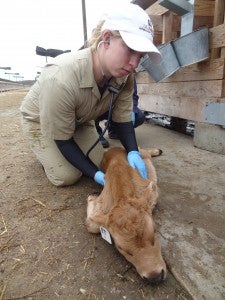 Describing a typical day at the VMTRC, she rises early to join a 6:00 a.m. on-field herd check on a client farm. This can include practice with palpations to diagnose pregnancy and pre- and post-birth health checks, such as administering vaccinations or drawing blood from young calves to check on immunization status. In the afternoon, the students may attend presentations by industry-leading UCD research faculty. They will also learn to digitally record and analyze the cattle’s health statistics in the areas of breeding, births, disease and treatment, and milk production. In pathology labs, she might conduct a calf necropsy and try to identify the cause of death.
Describing a typical day at the VMTRC, she rises early to join a 6:00 a.m. on-field herd check on a client farm. This can include practice with palpations to diagnose pregnancy and pre- and post-birth health checks, such as administering vaccinations or drawing blood from young calves to check on immunization status. In the afternoon, the students may attend presentations by industry-leading UCD research faculty. They will also learn to digitally record and analyze the cattle’s health statistics in the areas of breeding, births, disease and treatment, and milk production. In pathology labs, she might conduct a calf necropsy and try to identify the cause of death.
“I enjoy playing detective,” she said.
A veterinary career path less traveled
According to the American Veterinary Medical Association (AVMA), only about 17 percent of veterinarians work in food animal medicine, while more than 70 percent of veterinarians work with companion animals.
While our nation’s food supply is one of the safest in the world, keeping our food animals and food supply healthy and safe is one of the country’s most pressing issues. According to the FDA, with the growing push for a better national food safety system, there is a need for veterinarians who have large animal veterinary medicine expertise and who can work with food animals.
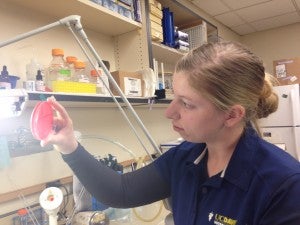 Michelle believes in the essential role of the veterinarian in training producers on dairy herd management and best practices. She wants to empower them to be successful in the production and care of healthy animals for a safe food supply.
Michelle believes in the essential role of the veterinarian in training producers on dairy herd management and best practices. She wants to empower them to be successful in the production and care of healthy animals for a safe food supply.
“I love being outside, seeing the cattle herd population as a whole, and learning about the management factors that go into keeping cows healthy,” she said.
As Michelle approaches graduation this spring and begins her job search, she hopes to find the perfect opportunity to put her life-long education, work and passion into practice. She knows that she and others will be the next generation of food animal veterinarians that will play a critical part in a strong system working to advance the health of animals, people and environment.
